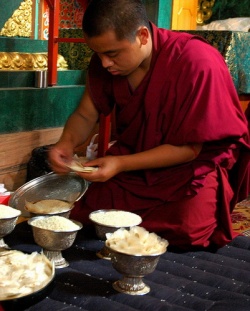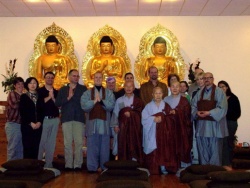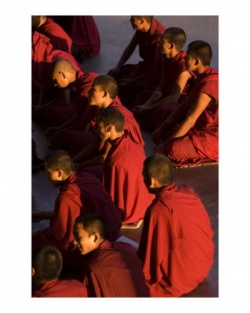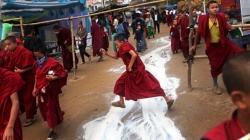Difference between revisions of "Shedra"
(Created page with "thumb|250px| <poem> Shedra is a Tibetan word {{BigTibetan|(བཤད་གྲྭ}}, bshad grwa) meaning "place of teaching" but...") |
|||
| Line 1: | Line 1: | ||
[[File:09bf946af.jpg|thumb|250px|]] | [[File:09bf946af.jpg|thumb|250px|]] | ||
| − | + | [[Shedra]] is a [[Tibetan]] [[word]] {{BigTibetan|([[བཤད་གྲྭ]]}}, [[bshad grwa]]) meaning "[[place of teaching]]" but specifically refers to the educational program in [[Tibetan Buddhist]] [[monasteries]] and nunneries. It is usually attended by [[monks and nuns]] between their early teen years and early twenties. Not all young [[monastics]] enter a [[shedra]]; some study [[ritual]] practices instead. [[Shedra]] is variously described as a {{Wiki|university}}, [[monastic]] {{Wiki|college}}, or [[philosophy]] school. The age range, however, corresponds to both secondary school and college. After completing a [[shedra]], some [[monks]] continue with further scholastic training toward a [[Khenpo]] or [[Geshe]] {{Wiki|degree}}, and other [[monks]] instead pursue training in [[ritual]] practices. | |
| − | |||
[[File:100 0936.jpg|thumb|250px|]] | [[File:100 0936.jpg|thumb|250px|]] | ||
| − | {{Wiki|Curriculum}} | + | |
| + | =={{Wiki|Curriculum}}== | ||
[[File:17-1714-VZQ1D.jpg|thumb|250px|]] | [[File:17-1714-VZQ1D.jpg|thumb|250px|]] | ||
The {{Wiki|curriculum}} varies with the [[lineage]] and [[monastery]] but most cover the main foundational texts in the [[Tibetan Buddhist canon]] such as the [[Mūlamadhyamakakārikā]] (The [[Fundamental Verses on the Middle Way]]) by [[Nagarjuna]] and the [[Madhyamakavatara]] ([[Entering the Middle Way]]) by [[Candrakīrti]]. Some non-Buddhist courses like {{Wiki|grammar}}, {{Wiki|poetry}}, {{Wiki|history}}, and arts may be included. The initial years focus on the [[Buddhist sutras]] and the remaining years on [[tantras]]. Care is taken to introduce foundational topics first, building key [[Wikipedia:concept|concepts]] and vocabulary for later study. | The {{Wiki|curriculum}} varies with the [[lineage]] and [[monastery]] but most cover the main foundational texts in the [[Tibetan Buddhist canon]] such as the [[Mūlamadhyamakakārikā]] (The [[Fundamental Verses on the Middle Way]]) by [[Nagarjuna]] and the [[Madhyamakavatara]] ([[Entering the Middle Way]]) by [[Candrakīrti]]. Some non-Buddhist courses like {{Wiki|grammar}}, {{Wiki|poetry}}, {{Wiki|history}}, and arts may be included. The initial years focus on the [[Buddhist sutras]] and the remaining years on [[tantras]]. Care is taken to introduce foundational topics first, building key [[Wikipedia:concept|concepts]] and vocabulary for later study. | ||
| − | + | ||
Compared to {{Wiki|western}} educational systems, the [[shedra]] places much [[greater]] emphasis on memorization. Some [[traditions]] require [[monks]] memorize complete texts before studying them. They may be required to recite in class the new [[sections]] they've memorized each day. In some [[lineages]], [[debate]] becomes a major focus and practice for refining one's [[understanding]]. In those [[lineages]] students may spend a major portion of the day in [[debate]] with each other. | Compared to {{Wiki|western}} educational systems, the [[shedra]] places much [[greater]] emphasis on memorization. Some [[traditions]] require [[monks]] memorize complete texts before studying them. They may be required to recite in class the new [[sections]] they've memorized each day. In some [[lineages]], [[debate]] becomes a major focus and practice for refining one's [[understanding]]. In those [[lineages]] students may spend a major portion of the day in [[debate]] with each other. | ||
| − | + | ||
There are also differing [[views]] on the importance of [[shedra]]. [[Gelug]] and [[Sakya]] [[lineages]] consider the [[shedra]] training [[essential]], whereas in the [[Nyingma]] and [[Kagyu]] [[lineages]] this is less the case. | There are also differing [[views]] on the importance of [[shedra]]. [[Gelug]] and [[Sakya]] [[lineages]] consider the [[shedra]] training [[essential]], whereas in the [[Nyingma]] and [[Kagyu]] [[lineages]] this is less the case. | ||
| − | Five Topics | + | |
| − | + | ===Five Topics=== | |
| − | [[Tsongkhapa]] standardized the [[Buddhist]] [[sutra]] {{Wiki|curriculum}} into | + | |
| + | [[Tsongkhapa]] standardized the [[Buddhist]] [[sutra]] {{Wiki|curriculum}} into five major topics, and this was later adopted by many other schools. | ||
[[File:20102 wblog.jpg|thumb|250px|]] | [[File:20102 wblog.jpg|thumb|250px|]] | ||
| − | + | # [[Paramitas]] - study of [[mahayana]] | |
| − | + | # [[Madhyamaka]] - [[philosophy]] | |
| − | + | # [[Pramana]] - [[logic]] and {{Wiki|epistemology}} | |
| − | + | # [[Abhidharma]] - {{Wiki|psychology}} | |
| − | + | # [[Vinaya]] - [[monastic rules]] | |
| − | [[Gelug | + | ===[[Gelug Lineage]]=== |
The [[shedra]] system at [[Sera Monastery]], now relocated to southern [[India]] from [[Tibet]], has a twelve- to twenty-year {{Wiki|curriculum}} organized in the five topics. The first five years are foundational and cover [[logic]], {{Wiki|epistemology}}, [[vinaya]], and the terms and distinctions built upon in later [[philosophic]] study. The next four years then study specific texts including [[Chandrakirti's]] [[Madhyamakavatara]], [[Maitreya's]] [[Abhisamayalankara]], and [[Dharmakirti's]] [[Pramanavarttika]]. The remaining four to eight years then continues with [[Vasubandu's]] [[Treasury of Manifest Knowledge]] and [[Gunaprabha's]] [[Vinayamula Sutra]], and for some students study of [[Guhyasamaja tantra]]. | The [[shedra]] system at [[Sera Monastery]], now relocated to southern [[India]] from [[Tibet]], has a twelve- to twenty-year {{Wiki|curriculum}} organized in the five topics. The first five years are foundational and cover [[logic]], {{Wiki|epistemology}}, [[vinaya]], and the terms and distinctions built upon in later [[philosophic]] study. The next four years then study specific texts including [[Chandrakirti's]] [[Madhyamakavatara]], [[Maitreya's]] [[Abhisamayalankara]], and [[Dharmakirti's]] [[Pramanavarttika]]. The remaining four to eight years then continues with [[Vasubandu's]] [[Treasury of Manifest Knowledge]] and [[Gunaprabha's]] [[Vinayamula Sutra]], and for some students study of [[Guhyasamaja tantra]]. | ||
| − | |||
| − | [[Nyingma]] [[Lineage]] | + | ===[[Nyingma]] [[Lineage]]=== |
| + | The [[shedra]] at [[Namdroling Monastery]] includes specific phases of study with particular texts used within each phase. Commentaries by [[Ju Mipham]] or [[Khenpo Shenga]] ([[Shenpen Chökyi Nangwa]]) may be used with each text. The phases and texts include: | ||
| − | The [[ | + | * First year |
| + | ** Training on the [[Pratimoksha]], [[Bodhisattva]], and [[Samaya]] [[vows]] using [[Treatise Ascertaining the Three Vows]] by [[Pema Wangyal]] | ||
| + | ** [[Bodhicharyavatara]] by [[Shantideva]] | ||
| + | ** {{Wiki|Grammar}}, {{Wiki|Poetry}}, and {{Wiki|History}} | ||
| + | * Second through fifth years | ||
| + | ** {{Wiki|Psychology}} using [[Abhidharmakosha]] by [[Vasubandu]], [[Abhidharmasamuccaya]] by [[Asanga]], and [[Pramanavarttika]] by [[Dharmakirti]] | ||
| + | ** [[Madhyamaka]] [[philosophy]] texts including [[Mūlamadhyamakakārikā]], [[Chatuhshataka-shastrakarika]] (The [[Four Hundred Verses on the Middle Way]]) of [[Aryadeva]], [[Madhyamakavatara]], and [[Madhyamakalankara]] | ||
| + | * Upper phase | ||
| + | ** [[Yogacara]] [[philosophy]] using the five treatises of [[Maitreya]] via [[Asanga]], including [[Gyulama]] ([[Mahayanottaratantrashastra]] or [[Ratnagotravibhaga]]), [[Abhisamayalankara]], [[Mahayanasutralankara]], [[Madhyantavibhanga]] ([[Distinguishing the Middle from the Extremes]]), and [[Dharmadharmatavibhaga]] ([[Distinguishing Phenomena and Pure Being]]) | ||
| + | ** Additional study on the [[vows]] and [[monastic]] [[discipline]] | ||
| + | * [[Tantra]] phase for two or three years | ||
| + | ** Specific [[tantras]] like the [[Guhyagarbha tantra]] | ||
| + | ** [[Dzogchen]] commentaries like [[Yonten Dzod]] by [[Jigme Lingpa]], [[Rangdrol Korsum]] ([[Trilogy of Self Liberation]]), and [[Ngelso Korsum]] ([[Trilogy of Resting]]) | ||
| + | ** Additional study on the [[eight precepts]] of practice and related topics | ||
| − | + | ===[[Kagyu Lineage]]=== | |
| − | |||
| − | |||
| − | |||
| − | |||
| − | |||
| − | |||
| − | |||
| − | |||
| − | |||
| − | |||
| − | |||
| − | |||
| − | |||
| − | |||
| − | [[Kagyu Lineage]] | ||
The following texts were recommended by the [[16th Karmapa]] as the basis for study in the [[shedra]] at [[Rumtek Monastery]]: | The following texts were recommended by the [[16th Karmapa]] as the basis for study in the [[shedra]] at [[Rumtek Monastery]]: | ||
| − | + | * [[Vinaya]], [[Abhidharma]] and {{Wiki|Epistemology}} | |
| − | + | ** [[Vinayamula Sutra]] by [[Gunaprabha]] with a commentary by [[Mikyö Dorje]] ([[8th Karmapa]]) | |
| − | + | ** [[Abhidharmakosha]] by [[Vasubandhu]] with a commentary by [[Mikyö Dorje]] | |
| − | + | ** [[Pramanavarttika]] by [[Dharmakirti]] with a commentary by [[Chödrak Gyatso]] ([[7th Karmapa]]) | |
| − | + | * [[Madhyamaka]] | |
| − | + | ** [[Madhyamakavatara]] by [[Chandrakirti]] with a commentary by [[Mikyö Dorje]] and another by [[Wangchuk Dorje]] ([[9th Karmapa]]) | |
| − | + | ** [[Abhisamayalankara]] by [[Maitreya]]-[[Asanga]] with a commentary by [[Mikyö Dorje]] which includes commentary by [[Indian]] [[scholar]] [[Haribhadra]]. | |
| − | + | * [[Tantra]] | |
| − | + | ** [[Uttaratantra Shastra]] by [[Maitreya]]-[[Asanga]] with commentaries by [[Jamgon Kongtrul Lodro Thaye]] and another by [[Gölo Shönu Pal]] as a basis for studying [[buddha nature]] | |
| − | + | ** [[Zabmo Nangdön]] by [[Rangjung Dorje]] ([[3rd Karmapa]]) with commentaries by [[Rangjung Dorje]] and [[Jamgon Kongtrul Lodro Thaye]] as a basis for [[tantra]] | |
| − | + | ** [[Hevajra Tantra]] with commentaries by [[Jamgon Kongtrul Lodro Thaye]] and [[Dakpo Tashi Namgyal]] | |
| − | {{Wiki|History}} | + | =={{Wiki|History}}== |
[[Monastic]] [[education]] and a [[tradition]] of {{Wiki|scholarship}} was not unique to [[Tibet]], but was imported when [[Buddhism]] was brought from [[India]] initially by [[Shantarakshita]]. Major [[Buddhist]] {{Wiki|universities}} such as [[Nalanda]] {{Wiki|University}} existed as places for advanced studies in [[India]] up until the twelfth century. | [[Monastic]] [[education]] and a [[tradition]] of {{Wiki|scholarship}} was not unique to [[Tibet]], but was imported when [[Buddhism]] was brought from [[India]] initially by [[Shantarakshita]]. Major [[Buddhist]] {{Wiki|universities}} such as [[Nalanda]] {{Wiki|University}} existed as places for advanced studies in [[India]] up until the twelfth century. | ||
| − | + | ||
{{W}} | {{W}} | ||
[[Category:Buddhist Education]] | [[Category:Buddhist Education]] | ||
Revision as of 13:16, 27 September 2013
Shedra is a Tibetan word (བཤད་གྲྭ, bshad grwa) meaning "place of teaching" but specifically refers to the educational program in Tibetan Buddhist monasteries and nunneries. It is usually attended by monks and nuns between their early teen years and early twenties. Not all young monastics enter a shedra; some study ritual practices instead. Shedra is variously described as a university, monastic college, or philosophy school. The age range, however, corresponds to both secondary school and college. After completing a shedra, some monks continue with further scholastic training toward a Khenpo or Geshe degree, and other monks instead pursue training in ritual practices.
Curriculum
The curriculum varies with the lineage and monastery but most cover the main foundational texts in the Tibetan Buddhist canon such as the Mūlamadhyamakakārikā (The Fundamental Verses on the Middle Way) by Nagarjuna and the Madhyamakavatara (Entering the Middle Way) by Candrakīrti. Some non-Buddhist courses like grammar, poetry, history, and arts may be included. The initial years focus on the Buddhist sutras and the remaining years on tantras. Care is taken to introduce foundational topics first, building key concepts and vocabulary for later study.
Compared to western educational systems, the shedra places much greater emphasis on memorization. Some traditions require monks memorize complete texts before studying them. They may be required to recite in class the new sections they've memorized each day. In some lineages, debate becomes a major focus and practice for refining one's understanding. In those lineages students may spend a major portion of the day in debate with each other.
There are also differing views on the importance of shedra. Gelug and Sakya lineages consider the shedra training essential, whereas in the Nyingma and Kagyu lineages this is less the case.
Five Topics
Tsongkhapa standardized the Buddhist sutra curriculum into five major topics, and this was later adopted by many other schools.
- Paramitas - study of mahayana
- Madhyamaka - philosophy
- Pramana - logic and epistemology
- Abhidharma - psychology
- Vinaya - monastic rules
Gelug Lineage
The shedra system at Sera Monastery, now relocated to southern India from Tibet, has a twelve- to twenty-year curriculum organized in the five topics. The first five years are foundational and cover logic, epistemology, vinaya, and the terms and distinctions built upon in later philosophic study. The next four years then study specific texts including Chandrakirti's Madhyamakavatara, Maitreya's Abhisamayalankara, and Dharmakirti's Pramanavarttika. The remaining four to eight years then continues with Vasubandu's Treasury of Manifest Knowledge and Gunaprabha's Vinayamula Sutra, and for some students study of Guhyasamaja tantra.
Nyingma Lineage
The shedra at Namdroling Monastery includes specific phases of study with particular texts used within each phase. Commentaries by Ju Mipham or Khenpo Shenga (Shenpen Chökyi Nangwa) may be used with each text. The phases and texts include:
- First year
- Training on the Pratimoksha, Bodhisattva, and Samaya vows using Treatise Ascertaining the Three Vows by Pema Wangyal
- Bodhicharyavatara by Shantideva
- Grammar, Poetry, and History
- Second through fifth years
- Psychology using Abhidharmakosha by Vasubandu, Abhidharmasamuccaya by Asanga, and Pramanavarttika by Dharmakirti
- Madhyamaka philosophy texts including Mūlamadhyamakakārikā, Chatuhshataka-shastrakarika (The Four Hundred Verses on the Middle Way) of Aryadeva, Madhyamakavatara, and Madhyamakalankara
- Upper phase
- Yogacara philosophy using the five treatises of Maitreya via Asanga, including Gyulama (Mahayanottaratantrashastra or Ratnagotravibhaga), Abhisamayalankara, Mahayanasutralankara, Madhyantavibhanga (Distinguishing the Middle from the Extremes), and Dharmadharmatavibhaga (Distinguishing Phenomena and Pure Being)
- Additional study on the vows and monastic discipline
- Tantra phase for two or three years
- Specific tantras like the Guhyagarbha tantra
- Dzogchen commentaries like Yonten Dzod by Jigme Lingpa, Rangdrol Korsum (Trilogy of Self Liberation), and Ngelso Korsum (Trilogy of Resting)
- Additional study on the eight precepts of practice and related topics
Kagyu Lineage
The following texts were recommended by the 16th Karmapa as the basis for study in the shedra at Rumtek Monastery:
- Vinaya, Abhidharma and Epistemology
- Vinayamula Sutra by Gunaprabha with a commentary by Mikyö Dorje (8th Karmapa)
- Abhidharmakosha by Vasubandhu with a commentary by Mikyö Dorje
- Pramanavarttika by Dharmakirti with a commentary by Chödrak Gyatso (7th Karmapa)
- Madhyamaka
- Madhyamakavatara by Chandrakirti with a commentary by Mikyö Dorje and another by Wangchuk Dorje (9th Karmapa)
- Abhisamayalankara by Maitreya-Asanga with a commentary by Mikyö Dorje which includes commentary by Indian scholar Haribhadra.
- Tantra
- Uttaratantra Shastra by Maitreya-Asanga with commentaries by Jamgon Kongtrul Lodro Thaye and another by Gölo Shönu Pal as a basis for studying buddha nature
- Zabmo Nangdön by Rangjung Dorje (3rd Karmapa) with commentaries by Rangjung Dorje and Jamgon Kongtrul Lodro Thaye as a basis for tantra
- Hevajra Tantra with commentaries by Jamgon Kongtrul Lodro Thaye and Dakpo Tashi Namgyal
History
Monastic education and a tradition of scholarship was not unique to Tibet, but was imported when Buddhism was brought from India initially by Shantarakshita. Major Buddhist universities such as Nalanda University existed as places for advanced studies in India up until the twelfth century.



